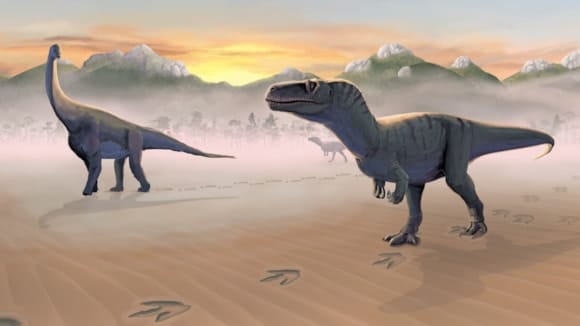Footprints Reveal T. Rex Ancestors Mingled on Scottish Island

By Jill Dando News
Despite being prehistoric predator and prey, massive meat-eating and plant-eating dinosaurs drank together from shallow freshwater lagoons on the Isle of Skye, 167 million years ago, according to newly identified tracks.
The 131 footprints at Prince Charles’s Point on Skye’s Trotternish Peninsula makes the site one of Scotland’s largest and, thanks to the dominance of footprints from carnivorous megalosaurs – cousins and ancestors of T. rex – one of the rarest in the world.
The discovery has given scientists invaluable insights into the environmental preferences and behaviours of dinosaurs from the Middle Jurassic period.
The site revealed footprints of plant-eating sauropods. Experts say their large, flat, circular impressions suggest they were made by a long-necked dinosaur two or three times the size of an elephant.
The footprints were once considered by geologists to be resting burrows of fish.
The area is also rich with footprints from jeep-sized megalosaurs, evidence of which from the Middle Jurassic period is scarce, experts say.
Analysis of the multi-directional tracks and walking gaits indicate that these dinosaurs milled around the lagoon’s margins, similar to how animals congregate around watering holes today.
The footprints suggest that, regardless of dominance, the meat-eating theropods and plant-eating sauropods habitually spent time in lagoons as opposed to exposed drier mudflats, researchers say.
The first three footprints at Prince Charles’s Point were discovered five years ago by a University of Edinburgh student and colleagues, who were visiting the shoreline.
Subsequent footprint discoveries have made the site one of the most extensive dinosaur track sites in Scotland, with scientists expecting to find more.
The research team took thousands of overlapping photographs of the entire site with a drone. Using specialist software, the team reconstructed digital 3D models of the footprints via a method called photogrammetry.
The remote bay on the Trotternish Peninsula was also the hiding place for Bonnie Prince Charlie, who sought shelter on the shoreline on 21 June 1746 with Flora MacDonald while being pursured by British troops.
The research, published in PLOS One, was funded by the Leverhulme Trust and National Geographic Society.
An accompanying feature-length documentary summarising the research is available to watch below:
Tone Blakesley, research lead and Masters in Palaeontology and Geobiology graduate from the School of GeoSciences, University of Edinburgh, said: "The footprints at Prince Charles's Point provide a fascinating insight into the behaviours and environmental distributions of meat-eating theropods and plant-eating, long-necked sauropods during an important time in their evolution. On Skye, these dinosaurs clearly preferred shallowly submerged lagoonal environments over subaerially exposed mudflats."
Steve Brusatte, Personal Chair of Palaeontology and Evolution from the School of GeoSciences, University of Edinburgh, said: "Prince Charles’s Point is a place where Scottish history and prehistory blend together. It’s astounding to think that when Bonnie Prince Charlie was running for his life, he might have been sprinting in the footsteps of dinosaurs."
Subscribe today in just 30 seconds to support our mission.
📢 Subscribe & be part of the movement:
👉 https://www.goodnewspost.co.uk/#/portal/
OUR VISION: A PEOPLE-FIRST WORLD NEWS
The world is drowning in bad news. Anxiety, fear, and negativity dominate headlines. Social media fuels 24/7 doomscrolling, and a mental health crisis is spiraling out of control.
ENOUGH IS ENOUGH. IT’S TIME TO FIGHT BACK.
That's why we created The Good News Post—a positive news ecosystem designed to put people first and inspire a world that is:
Deliberately social media-free. Join us where real connection happens





